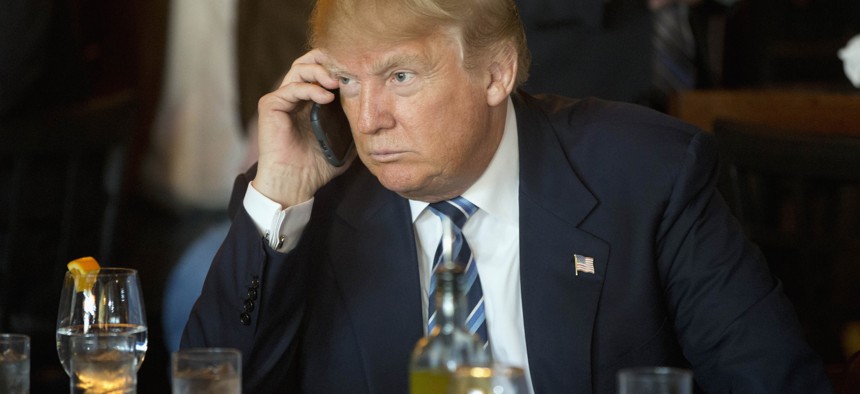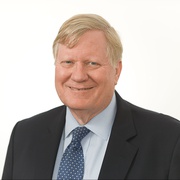
Then-Republican presidential candidate Donald Trump listens to his mobile phone during a lunch stop in North Charleston, S.C. Matt Rourke/AP
How to Make Donald Trump’s Phone Safe
The man who led the effort to let President Obama keep his BlackBerry says the best solution for Trump might be multiple devices.
Eight years after he was the man trying to grant Barack Obama’s plea to keep his BlackBerry, Richard “Dickie” George is watching with more than casual interest while another president-elect fights to keep his smartphone as a lifeline out of the bubble that is the modern presidency.
Obama won that battle—sort of—thanks to the work of a team at the National Security Agency headed by George, and thanks to the president’s willingness to accept severe restrictions.
Today, the challenges presented by President-elect Donald Trump’s heavy use of social media on an unsecured Android phone are considerably more daunting. And the outcome is less than clear only five weeks before the Inauguration.
Trump transition officials will not talk about the issue, not even responding to questions on whether they have had any discussions with the NSA. The president-elect, in an interview with CBS’s 60 Minutesshortly after the election, promised to be “very restrained” with Twitter “if I use it at all.” With 17.3 million followers, he sees Twitter as “a method of fighting back” against criticism.
Indeed, in his postelection tweets, he has attacked The New York Times, Vanity Fair, CNN, NBC News, and Saturday Night Live. On Dec. 5, he seemed to answer the question about his future tweets when he tweeted: “If the press would cover me accurately & honorably, I would have far less reason to ‘tweet.’ Sadly, I don’t know if that will ever happen!”
That means the NSA, which is in charge of protecting U.S. government communications and information systems, will have to deal with a tweet-happy president, one who has told his aides he does not want to surrender his Samsung Galaxy S4. It’s exactly the type of challenge George thrived on during his 41 years with the NSA. Before he retired in 2011 and became senior adviser for cybersecurity at the Johns Hopkins Applied Physics Lab, George had spent the previous eight years at the NSA as technical director for the Information Assurance Directorate.
He was in that job on Election Day in 2008 when he was told to find a way to let Obama keep his BlackBerry. In an interview this week with National Journal, George compared the assignment to the NSA’s development of “Vinson,” a secure voice-encryption unit that was a forerunner of the cell phone. “We designed that in 1957. We built the first model in 1970, and we fixed everything we found wrong through the first few engineering models, and we fielded it in 1976. It took 19 years to get that thing out,” he said, contrasting that with the three-month time frame to reengineer Obama’s phone.
To do it, he assembled a core team of about a dozen, with up to another 50 working on the project. In the end, after tweaking the phone’s algorithms and engineering, he presented the new president with a severely limited device. Obama could call and receive calls from only a handful of close friends—who first had to be briefed by the White House counsel’s office and have their devices examined. He could not click on any attachments and could not tweet. “And he wasn’t playing Angry Birds, I can promise you that,” joked George.
In Obama’s last year in office, the NSA replaced his BlackBerry with a new phone. The limitations remained in force, as the president joked in an appearance on The Tonight Show with Jimmy Fallon on June 9. Obama recalled what he was told when given the new device: “This is a great phone—state of the art. But it doesn’t take pictures, you can’t text, the phone doesn’t work, and you can’t play your music on it,” he joked.
George was watching Fallon that night and laughed along with the president. “I thought his characterization was right on. In fact, I laughed with my wife and told her, ‘Boy, did he get that right.’”
The limitations are critical because the threat is so dire, he said. “We are all targets,” he said. “But he has got a much bigger bull’s-eye on his back than I do or anybody else.” He added that it is almost certain that a president would be sent false links, often disguised as coming from legitimate sources. “If someone can get into the secretary of Defense system and send a message to the president with a ‘You need to read this’ link, the chances are much better that he is going to click on that than if it comes from some person he’s never heard of.”
If a president is not careful, he could surrender control of his phone, his camera, and the device’s microphone and GPS. “People are going to try a lot harder, spend a lot more resources to get him. You’ve got to protect yourself,” said George.
Trump’s postelection tweets also have raised the possibility of hackers sending out fake tweets that look as if they came from Trump and have the potential of affecting the stock market or triggering foreign crises. Two companies already saw their values drop following barbed early-morning tweets from Trump. On Dec. 6, he criticized the amount he said—inaccurately—Boeing was spending on a new Air Force One, demanding, “Cancel order!” Boeing’s shares lost almost 1 percent at the opening of trading on the New York Stock Exchange. Six days later, Lockheed Martin suffered a more than 5 percent hit after Trump tweeted that the cost of the F-35 fighter jet program was “out of control.”
“And,” said George, “those were really mild things he said. You could really tank a company if you wanted to” with a fake tweet. “The impact he can have is phenomenal.”
For Trump, George suspects the answer will be giving him multiple devices. “It’s not like he is only going to have one device to do things from. And it’s not like he has to worry about carrying extra devices. There are people who will be carrying stuff for him.” George said the functionality of one device can be limited to sending tweets. “This is the device that you only Twitter on. You don’t take phone calls, you don’t send emails. You Twitter on this and nobody is calling you on this.” Another phone would be used for calls to his family.
NSA officials know, though, that no president has to listen to them. They can only hope that Trump is as cooperative as Obama was. “He is the president; he gets to make the risk-management decision,” said George. “The good news was that Obama was about as easy to work with as you could imagine. He didn’t fight us at any step. He took it really seriously, and what more could you ask for?”
With Trump, he said, “We can suggest. But no one is going to tell him.” He added, “This is the president. He can do what he wants. But presidents are inherently really smart people. They understand the risks that they take and they try to play the game right. You don’t get to be president if you don’t understand that kind of stuff.”





